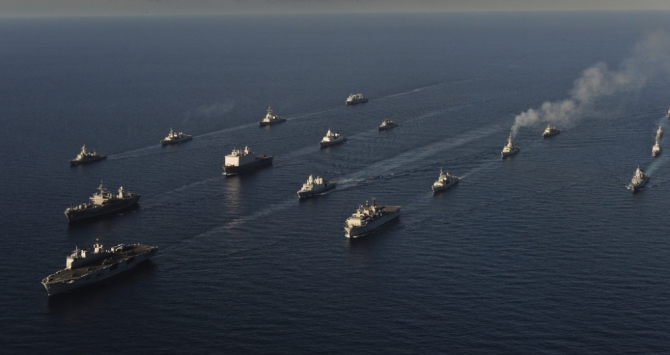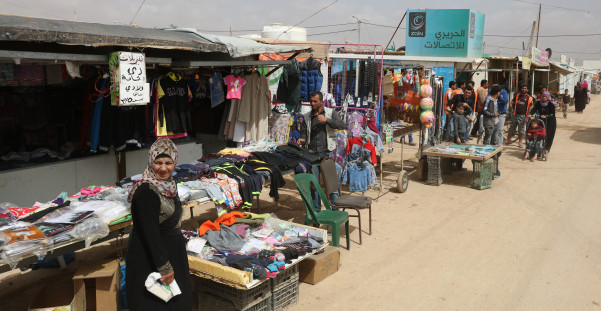In an article for IRIN Ruben Andersson looks at why warships can’t solve the refugee crisis and puts forward a few suggestions for more effective solutions.
Another week, another project scrawled on the back of a napkin to try to solve the refugee crisis. This time it’s ‘send in the warships’.

The panicky decision to involve NATO is not only an unprecedented step in the militarisation of Europe’s borders but also fits into the long-term trend of viewing refugees and migrants arriving by boat as an emergency that can only be addressed with increased border security.
Ever since Europe’s Schengen agreement on free movement was rolled out in the 1990s, governments have rallied around the task of securing Europe’s external borders as a substitute for a genuinely common EU approach to migration and asylum. There’s only one problem: it has never worked. As researchers (including myself) have explained time and again, attempts to curtail migration by simply policing a borderline and launching deterrence policies will solve nothing if the root causes – from deepening global inequality to labour demand at destination, and from cross-border kinship networks to violence and repression – remain unaddressed. Instead, they just make the situation worse – more chaotic, more deadly, more predatory.
A vicious cycle has ensued, as politicians have administered more of the same toxic medicine in response to each new ‘crisis’ at Europe’s borders, from Lesvos to Lampedusa. For a long time they got away with it, but with more than one million people arriving across the Mediterranean in 2015 alone they can no longer pretend the border security approach has worked. Faced with this failure, European leaders have no explanations or alternatives to offer their electorates; worse, they are now applying the same destructive approach to policing their countries’ own borders in a race to the bottom, with not a shred of Union in sight.
Yet we also need to recognise how failure resembles ‘success’ for the many actors that have come to feed off the punitive approach to migration – European politicians keen to present a tough image to their electorates; border agencies; defense and security companies; and states bordering the EU, which have used migrants as a cash cow, bargaining chip and even a ‘weapon’ launched against a fearful Europe.
So, what to do?
1. Learn from other failed ‘wars’
Just as the ‘fight against migration’ has largely failed to contain human movements across frontiers, the ‘war on drugs’ is now acknowledged to be an immensely costly, destructive and ultimately futile exercise. We can draw on the concept of ‘harm reduction’ that has started to be applied (albeit modestly) in relation to drugs, for example by cutting some of the most counterproductive security measures that now put people at risk – including mass detention, pushbacks and fencing – while bolstering humane alternatives through targeted EU funding. The biggest harm reduction measure of all is simple, and already within member states’ reach: the introduction of legal pathways, allowing for safe, organised arrivals rather than chaotic and dangerous entry methods.
2. Assess the true costs of the ‘border security model’
Taxpayer spend on border security and migration controls is extremely hard to assess at present, but a recent cross-European journalistic investigation unearthed some €11 billion in spending on deportations alone since the early 2000s. And it’s not just upfront security costs: Europe has long used development aid to help convince African states to roll out measures to deter migration. Yet counting the cents is not enough – we also need to assess the larger social, political, environmental and economic costs. Closed legal routes and beggar-thy-neighbour border security have put enormous pressure on border areas across Europe, resulting in dented tourism,trampled crops and social unrest – not to mention the thousands of lives lost to the waves. Politically, the costs are rising too. Schengen is now at risk of rupturing; external states on key migration routes have gained huge leverage from Europe’s sense of panic; and the rest of the world looks on askance as advanced economies let people perish on their front porch. A full evaluation of border security costs including its financial, social, political and humanitarian consequences would help build momentum for a shift – and sensible politicians should push for it.
3. A global strategy for mobility
This entails treating migration not as an emergency and a threat, but as a perennial feature of human life that can – if we treat it right – hold significant opportunities. A strategic shift can take place through four interlocked steps: first, by de-escalating the debate and tempering the emergency talk, which has only served to bolster the security model. Second, by forging a different kind of collaboration with states neighbouring Europe, scrapping the destructive ‘fight against migration’ and instead exchanging expertise in fields such as healthcare and education. Third, by applying a genuinely normalised treatment of migration within Europe via responsibility-sharing of a more positive kind than ‘mandatory quotas’, while shifting migration issues away from ‘Home Affairs’ towards other directorates-general in Brussels – or even creating a new one for mobility. And fourth, beyond the European sphere, by working towards a fully global approach to migration that strengthens shared refugee responsibility under the UNHCR umbrella while also crucially involving other forms of migration. If European leaders get their house in order – a big if – they would be able to act as credible partners in this year’s UN deliberations, generating goodwill for more responsibility-sharing by other rich states.
4. Build broad coalitions for change
Chances are slight that the very European leaders who have so far only agreed on the border security model will shift away from it by their own choice. To push for change, we can learn from coalitions forged in other contentious fields. Much as in fossil fuel-burning or in the destructive drug wars, the risks generated by the ‘fight against migration’ have been distributed unevenly. While a large industry has been forged around border security, those most affected by its negative outcomes – border communities as well as frontline workers and volunteers dealing with the mess; European and non-European states that have taken in more than their fair share of asylum seekers; and origin countries and communities that have seen their citizens perish – could become the drivers behind a motley coalition for mobility. In this coalition, migrants and refugees themselves must play a key role. People fleeing barrel bombs to bring their families to safety, or hiding from Libyan militias before setting off for Europe, have enormous skills, ambitions and insights to offer.
None of this is a quick fix, and neither is addressing the major drivers of the global refugee crisis, namely brutal wars and repression. Yet this lack of a silver bullet should be welcomed in our political debate, since the opposite – the quick fix of border security – has proven to be no solution at all.
For more on Ruben Andersson’s recommendation for a less destructive approach, see his full research paper, here.
This article was reproduced with the kind permission of IRIN. The original post can be found here.
 Ruben Andersson is an anthropologist at the London School of Economics and Political Science working on migration, borders and security. He is a postdoctoral research fellow at LSE’s Civil Society and Human Security Research Unit, Department of International Development, and an associated researcher at Stockholm University’s Department of Anthropology.
Ruben Andersson is an anthropologist at the London School of Economics and Political Science working on migration, borders and security. He is a postdoctoral research fellow at LSE’s Civil Society and Human Security Research Unit, Department of International Development, and an associated researcher at Stockholm University’s Department of Anthropology.





